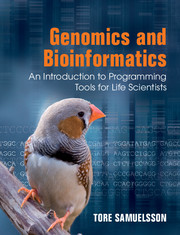Book contents
- Frontmatter
- Contents
- Preface
- Acknowledgements
- Design and conventions of this book
- 1 Introduction: working with the molecules of life in the computer
- 2 Gene technology: cutting DNA
- 3 Gene technology: knocking genes down
- 4 Gene technology: amplifying DNA
- 5 Human disease: when DNA sequences are toxic
- 6 Human disease: iron imbalance and the iron responsive element
- 7 Human disease: cancer as a result of aberrant proteins
- 8 Evolution: what makes us human?
- 9 Evolution: resolving a criminal case
- 10 Evolution: the sad case of the Tasmanian tiger
- 11 A function to every gene: termites, metagenomics and learning about the function of a sequence
- 12 A function to every gene: royal blood and order in the sequence universe
- 13 A function to every gene: a slimy molecule
- 14 Information resources: learning about flu viruses
- 15 Finding genes: going ashore at CpG islands
- 16 Finding genes: in the world of snurpsp
- 17 Finding genes: hunting for the distant RNA relatives
- 18 Personal genomes: the differences between you and me
- 19 Personal genomes: what’s in my genome?
- 20 Personal genomes: details of family genetics
- Appendix I Brief Unix reference
- Appendix II A selection of biological sequence analysis software
- Appendix III A short Perl reference
- Appendix IV A brief introduction to R
- Index
- References
3 - Gene technology: knocking genes down
Published online by Cambridge University Press: 05 August 2012
- Frontmatter
- Contents
- Preface
- Acknowledgements
- Design and conventions of this book
- 1 Introduction: working with the molecules of life in the computer
- 2 Gene technology: cutting DNA
- 3 Gene technology: knocking genes down
- 4 Gene technology: amplifying DNA
- 5 Human disease: when DNA sequences are toxic
- 6 Human disease: iron imbalance and the iron responsive element
- 7 Human disease: cancer as a result of aberrant proteins
- 8 Evolution: what makes us human?
- 9 Evolution: resolving a criminal case
- 10 Evolution: the sad case of the Tasmanian tiger
- 11 A function to every gene: termites, metagenomics and learning about the function of a sequence
- 12 A function to every gene: royal blood and order in the sequence universe
- 13 A function to every gene: a slimy molecule
- 14 Information resources: learning about flu viruses
- 15 Finding genes: going ashore at CpG islands
- 16 Finding genes: in the world of snurpsp
- 17 Finding genes: hunting for the distant RNA relatives
- 18 Personal genomes: the differences between you and me
- 19 Personal genomes: what’s in my genome?
- 20 Personal genomes: details of family genetics
- Appendix I Brief Unix reference
- Appendix II A selection of biological sequence analysis software
- Appendix III A short Perl reference
- Appendix IV A brief introduction to R
- Index
- References
Summary
Restriction enzymes, one of many tools of the molecular biology toolbox, were introduced in the previous chapter. The present chapter is devoted to another important method designed to examine the function of specific genes.
Interfering with gene expression
In order to study the biological function of a gene, the molecular biologist needs methods that allow alteration of that gene – for example, an alteration that reduces the production of the protein specified by the gene. The behaviour of a normal cell may then be compared to a cell where the gene of interest has been manipulated, thereby allowing a conclusion regarding the function of the gene of interest. In the yeast Saccharomyces cerevisiae, for instance, there are methods that allow the complete removal of genes (such a removal is often referred to as a gene knock-out ). If, for instance, the yeast gene named PSY3 is removed or inactivated, it gives rise to an increased level of mutations. This observation suggests to us that this particular gene is related to the repair of DNA damage.
For studies of human genes, you may want to examine a species more closely related to man than is yeast. You can delete or inactivate genes in mammals such as mice, but this is more technically involved than in yeast. On the other hand, there are other methods that make possible a reduction in gene expression in animals. One such important method involves RNA interference (RNAi) (also known as RNA silencing). In one common type of experiment, an mRNA is inactivated by the introduction of a small synthetic RNA which is complementary to the mRNA. In the bioinformatics example below we will see how we can design a small RNA for such an experiment. RNAi is an example of a gene knock-down method, as the expression of the target gene is reduced (compared to the gene knock-out, where a specific gene is completely removed or inactivated).
Information
- Type
- Chapter
- Information
- Genomics and BioinformaticsAn Introduction to Programming Tools for Life Scientists, pp. 31 - 43Publisher: Cambridge University PressPrint publication year: 2012
